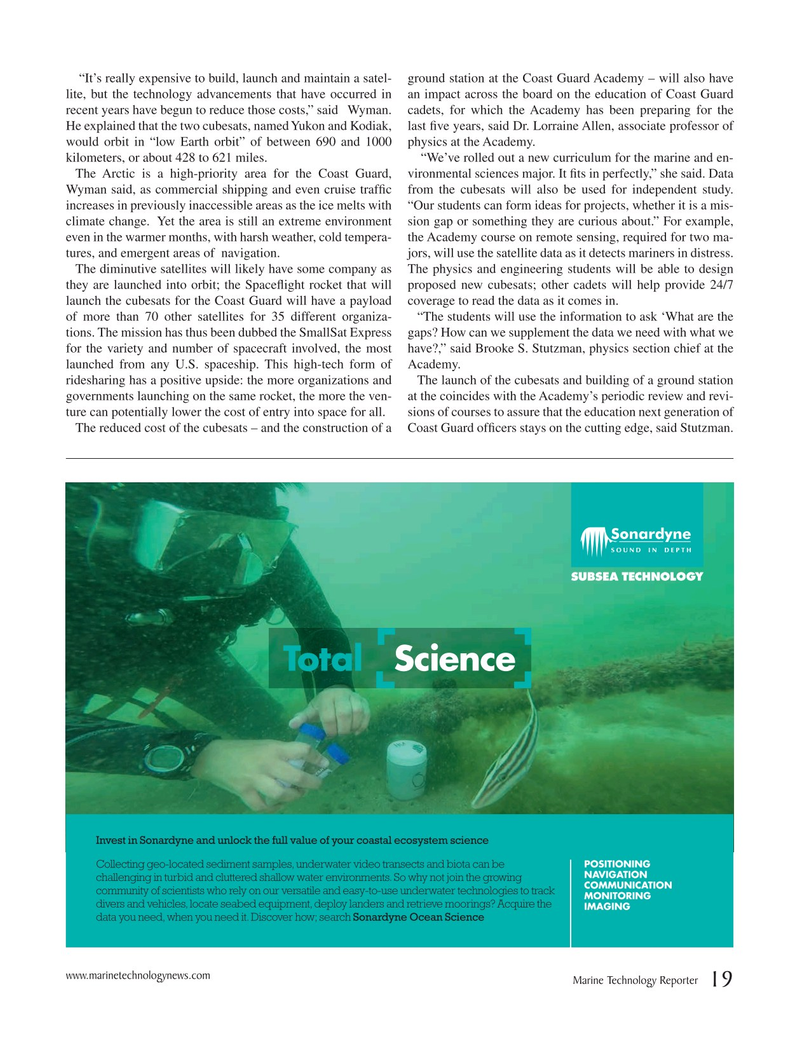
Page 19: of Marine Technology Magazine (March 2019)
Oceanographic Instrumentation: Measurement, Process & Analysis
Read this page in Pdf, Flash or Html5 edition of March 2019 Marine Technology Magazine
“It’s really expensive to build, launch and maintain a satel- ground station at the Coast Guard Academy – will also have lite, but the technology advancements that have occurred in an impact across the board on the education of Coast Guard recent years have begun to reduce those costs,” said Wyman. cadets, for which the Academy has been preparing for the
He explained that the two cubesats, named Yukon and Kodiak, last ? ve years, said Dr. Lorraine Allen, associate professor of would orbit in “low Earth orbit” of between 690 and 1000 physics at the Academy. kilometers, or about 428 to 621 miles. “We’ve rolled out a new curriculum for the marine and en-
The Arctic is a high-priority area for the Coast Guard, vironmental sciences major. It ? ts in perfectly,” she said. Data
Wyman said, as commercial shipping and even cruise traf? c from the cubesats will also be used for independent study. increases in previously inaccessible areas as the ice melts with “Our students can form ideas for projects, whether it is a mis- climate change. Yet the area is still an extreme environment sion gap or something they are curious about.” For example, even in the warmer months, with harsh weather, cold tempera- the Academy course on remote sensing, required for two ma- tures, and emergent areas of navigation. jors, will use the satellite data as it detects mariners in distress.
The diminutive satellites will likely have some company as The physics and engineering students will be able to design they are launched into orbit; the Space? ight rocket that will proposed new cubesats; other cadets will help provide 24/7 launch the cubesats for the Coast Guard will have a payload coverage to read the data as it comes in.
of more than 70 other satellites for 35 different organiza- “The students will use the information to ask ‘What are the tions. The mission has thus been dubbed the SmallSat Express gaps? How can we supplement the data we need with what we for the variety and number of spacecraft involved, the most have?,” said Brooke S. Stutzman, physics section chief at the launched from any U.S. spaceship. This high-tech form of Academy. ridesharing has a positive upside: the more organizations and The launch of the cubesats and building of a ground station governments launching on the same rocket, the more the ven- at the coincides with the Academy’s periodic review and revi- ture can potentially lower the cost of entry into space for all. sions of courses to assure that the education next generation of
The reduced cost of the cubesats – and the construction of a Coast Guard of? cers stays on the cutting edge, said Stutzman.
SUBSEATECHNOLOGY
Total Science
Invest in Sonardyne and unlock the full value of your coastal ecosystem science
POSITIONING
Collecting geo-located sediment samples, underwater video transects and biota can be
NAVIGATION challenging in turbid and cluttered shallow water environments. So why not join the growing
COMMUNICATION community of scientists who rely on our versatile and easy-to-use underwater technologies to track
MONITORING divers and vehicles, locate seabed equipment, deploy landers and retrieve moorings? Acquire the
IMAGING data you need, when you need it. Discover how;search Sonardyne Ocean Science www.marinetechnologynews.com
Marine Technology Reporter 19
MTR #2 (18-33).indd 19 3/11/2019 11:02:34 AM

 18
18

 20
20
